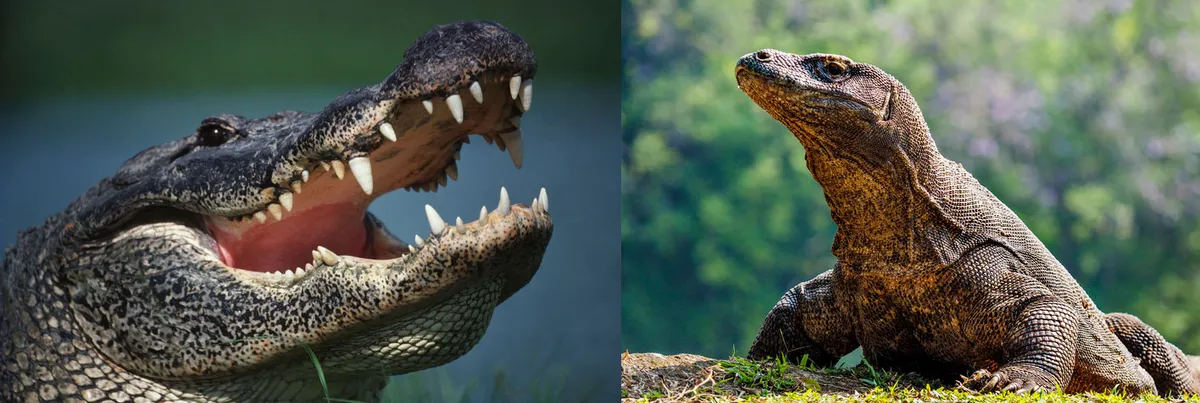The fearsome Tyrannosaurus rex bit through bone by keeping a joint in its lower jaw steady like an alligator, rather than flexible like a snake, a new study suggests.
Researchers say the finding over the famous carnivorous dinosaur sheds new light on a mystery that has puzzled palaeontologists.
Dinosaurs had a joint in the middle of their lower jaws, called the intramandibular joint, which is also present in modern-day reptiles. Previous research suggested this joint was flexible – like in snakes and monitor lizards, helping carnivorous dinosaurs to keep struggling prey in their jaws.
However, it has been unclear whether the jaws were flexible at all, or how they could be strong enough to bite through and ingest bone – which T. rex did regularly, according to fossil evidence.
“We discovered that these joints likely were not flexible at all, as dinosaurs like T. rex possess specialised bones that cross the joint to stiffen the lower jaw," said John Fortner, a doctoral student in anatomy at the University of Missouri and the lead author of the study.

Researchers used CT scans of dinosaur fossils and modern reptiles to build a detailed 3D model of the T. rex jaw. Their simulations included bone, tendons and specialised muscles that wrap around the back of the jaw, or mandible, which previous studies did not.
“We are modelling dinosaur jaws in a way that simply has not been done before," said Fortner.“We are the first to generate a 3D model of a dinosaur mandible which incorporates not only an intramandibular joint, but also simulates the soft tissues within and around the jaw.”
The research is presented at the American Association for Anatomy annual meeting during the Experimental Biology (EB) 2021 meeting, held virtually from 27 to 30 April.
Read more abouttheT. rex:
- The T. rex didn’t get its bone-crunching bite until adulthood
- Teenage T. rexoutcompeted smaller rivals, new study suggests
- Look inside a dinosaur's skull with these pictures from the pop-up book Tyrannosaurus Rex
To look at whether the intramandibular joint could maintain flexibility under the forces required to crunch through bone, the team ran a series of simulations to calculate the strains that would occur at various points depending on where the jaw hinged.
Their findings suggest bone running along the inside of the jaw, called the prearticular, acted as a strain sink to counteract bending at the intramandibular joint, keeping the lower jaw stiff.
“Because dinosaur mandibles are actually built so much like living reptiles, we can use the anatomy of living reptiles to inform how we construct our mandible models," Fortner added.
“In turn, the discoveries we make about T. rex’s mandible can provide more clarity on the diversity of feeding function in today’s reptiles, like crocodilians and birds.”
Reader Q&A: Would dinosaurs have gotten even bigger if they weren't wiped out?
Asked by: Joshua Irwandi, Leeds
What might have happened if that asteroid missed? Huge dinosaurs would have likely persisted. In fact, as Earth’s temperature has decreasedsince they roamed, it’s possible that – like other animals in colder conditions – dinosaurs would have got bigger.
It’s important to remember here that dinosaurs were already massive. For instance,Tyrannosaurus rexwas the largest pure predator that ever lived on land: it was the size of a double-decker bus, about 13 metres long and weighing eight tonnes. Some long-necked sauropods likeArgentinosaurusandPatagotitanwere more than 30 metres (100 feet) long and weighedin excess of60 tonnes – heftier than a Boeing 737. They werethe biggest animals to ever walk Earth.
Palaeontologists have long wondered why dinosaurs got so large in the first place. Early scientists suspected it might be related to the physical environment: maybe gravity was weaker during the Age of Dinosaurs, or the atmosphere was swamped with oxygen.
Yet we now know this was not the case: dinosaurs were big for their own intrinsic, biological reasons. The largest sauropods, for example, had a perfect combination of features that allowed them to supersize. Their long necks gave them access to a never-ending buffet of plants other animals couldn’t reach. They had efficient lungs that took in more oxygen than mammal lungs. And those lungs were connected to air sacsthatcooled their bodies.
Although they died when the Chicxulub asteroid hit 66 million years ago, it’s likely these sauropods were already close to their biological limit. Any larger and it’s possible they wouldn’t have been able to move, breathe, or hold up their bodies.
But while this is speculation, one thing is clear: if huge dinosaurs survived today, big mammals like elephants or rhinos wouldn’t have the space to co-exist. Mammals would stillbe in the shadows.
Read more: